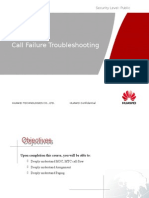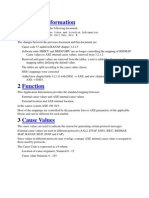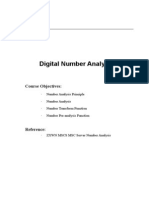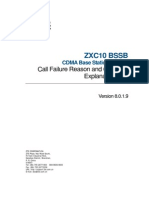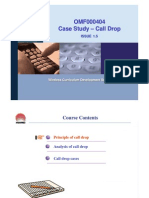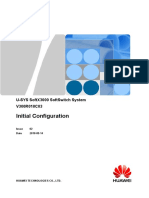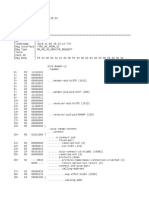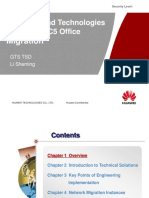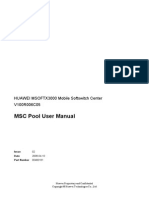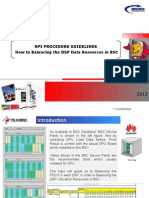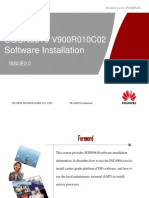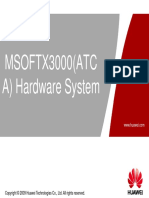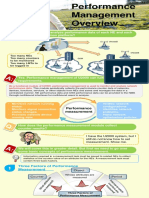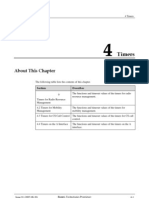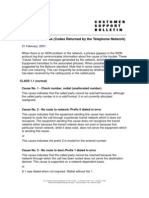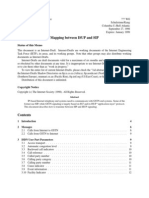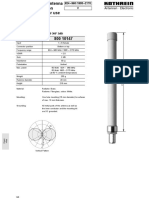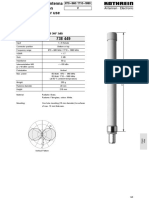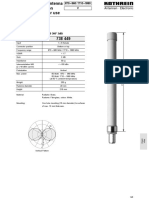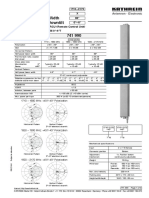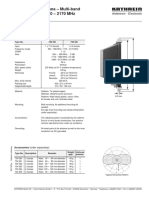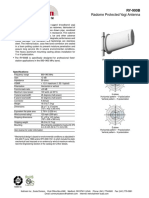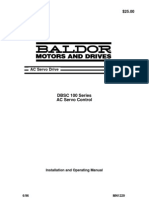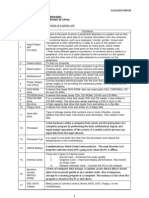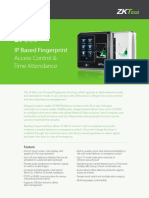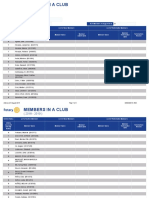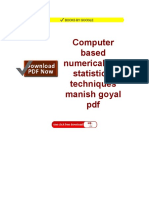02-C Description of Failure Cause Code
Uploaded by
Virgil Peiulescu02-C Description of Failure Cause Code
Uploaded by
Virgil PeiulescuHUAWEI MSOFTX3000
Configuration Guide Contents
Contents
C Description of Failure Cause Code.......................................................................................C-1
C.1 Definition of Failure Cause Code ................................................................................................................ C-2
C.2 Description of Internal Failure Cause Code ................................................................................................ C-4
Issue 01 (2007-08-15) Huawei Technologies Proprietary i
HUAWEI MSOFTX3000
Tables Configuration Guide
Tables
Table C-1 Mapping relationship between the ISUP standard failure cause code and internal failure cause code
............................................................................................................................................................................ C-3
ii Huawei Technologies Proprietary Issue 01 (2007-08-15)
HUAWEI MSOFTX3000
Configuration Guide C Description of Failure Cause Code
C Description of Failure Cause Code
About This Chapter
The following table lists the contents of this chapter.
Section Describes
C.1 Definition of Failure The definition of the failure cause code.
Cause Code
C.2 Description of Internal Failure causes corresponding to internal failure cause
Failure Cause Code codes, and failure analysis.
Issue 01 (2007-08-15) Huawei Technologies Proprietary C-1
HUAWEI MSOFTX3000
C Description of Failure Cause Code Configuration Guide
C.1 Definition of Failure Cause Code
Basic Concepts
The failure cause code is also called failure cause value, release cause value, or protocol cause
value. It is used to describe the exceptions during the call connection. The exceptions include:
z User is busy.
z User does not respond.
z User does not answer the call.
z There is no idle circuit.
z Switching device is congested.
The call control signaling of each type of protocol (such as ISUP, BICC, and SIP) defines its
own failure cause codes. The device at one end generates a failure cause code and sends it to
the device at the other end through signaling. Then the connection to the device at the other
end is affected greatly.
For example, suppose that Office A interconnects with Office B through the ISUP protocol.
When Office A sends an IAM to Office B to request a call setup, if Office B determines that
the callee is busy, Office B sends a REL to instruct Office A to release the call. The REL
returned by Office B contains the failure cause code (17). As instructed by this failure cause
code, Office A can implement either of the following operations:
z Office A releases the call.
z Office A plays the tone "Sorry! The subscriber you dialed is busy now".
In actual networking, the devices at two ends can be interconnected successfully only when
they understand the failure cause code in the same way. Therefore, international organizations
for standardization (such as ITU-T and 3GPP) define the failure cause code clearly in the
protocol.
For example, the ITU-T defines that the failure cause code ranges from 0 to 127. Among these,
the failure cause codes numbered from 0 to 31 stand for general events while those numbered
from 32 to 47 stand for resource unavailability.
Processing of Failure Cause Code in the MSOFTX3000
In the software for call processing, the MSOFTX3000 extends the value range of failure cause
code to 0–254 (code numbered 255 is invalid). Among these, the failure cause codes
numbered from 0 to 127 are defined by Huawei while most of the others map the failure cause
codes defined by ITU-T ISUP protocol.
When the MSOFTX3000 interconnects with other devices through inter-office signaling, the
MSOFTX3000 converts the internal failure cause code into the standard code in a certain
manner.
The failure cause code in ADD CLDPREANA, ADD PFXPRO, ADD CNACLR, and ADD
CLICRTANA is the internal failure cause code. The original cause value type and target cause value
type in ADD CVTCAU are standard failure cause codes defined by protocols.
C-2 Huawei Technologies Proprietary Issue 01 (2007-08-15)
HUAWEI MSOFTX3000
Configuration Guide C Description of Failure Cause Code
For example, the ISUP signaling sent from the peer office to the MSOFTX3000 contains the
standard failure cause code (ranging from 0 to 127). Normally, the MSOFTX3000 converts
the standard failure cause code into internal failure cause code by adding 128 to the standard
failure cause code.
Table C-1 lists the mapping relationship between the ISUP standard failure cause code and
internal failure cause code.
Table C-1 Mapping relationship between the ISUP standard failure cause code and internal failure
cause code
Cause Level ISUP Standard Failure Cause Internal Failure Cause Code
Code
Internal failure – 0–127
cause code
Normal 0–31 128–159
No resource 32–47 160–175
available
No service or 48–63 176–191
optional item
available
Service or optional 64–79 192–207
item not
implemented
Invalid message 80–95 208–223
Protocol error 96–111 224–239
Interworking 112–127 240–254
The failure cause code defined by various protocols varies significantly in quantity and
definition. Therefore, the conversion is implemented in the MSOFXT3000 in different
manners. By default, the conversion in the MSOFXT3000 can support adaptation of the
failure cause code in most networking applications. If there are special requirements of the
failure cause code contained in the inter-office signaling, run ADD CVTCAU under the
guidance of Huawei technical support engineers.
In addition, if internal cause code is used for querying the configuration of MOD
CAUSETONE, ADD CFPRO, and ADD FAILSP, you must get an overview of internal
failure cause code defined by the MSOFTX3000.
Issue 01 (2007-08-15) Huawei Technologies Proprietary C-3
HUAWEI MSOFTX3000
C Description of Failure Cause Code Configuration Guide
C.2 Description of Internal Failure Cause Code
Code Description Cause
CV0 Supplementary service It is not used currently.
activation conflicted
CV1 Supplementary service It is not used currently.
activation succeeded
CV2 Supplementary service It is not used currently.
activation failed
CV3 Supplementary service It is not used currently.
cancellation succeeded
CV4 Supplementary service It is not used currently.
cancellation failed
CV5 Supplementary service It is not used currently.
checking succeeded
CV6 Supplementary service It is not used currently.
checking failed
CV7 Supplementary service usage It is not used currently.
succeeded
CV8 Supplementary service usage It is not used currently.
failed
CV9 Malicious call tracing It is not used currently.
succeeded
CV10 Malicious call tracing failed It is not used currently.
CV11 Absent service set on peer It is not used currently.
office
CV12 Do-not-disturb service set on It is not used currently.
peer office
CV13 Switching device congestion The congestion results from insufficient
resources in switching device. This cause is
generated in the following cases:
z The MSC lacks internal resources.
z Some timers in the MSC expire. They
cannot be used for timing.
z Some users register AOCC or AOCI service
but there is no corresponding data
configured in the MSC.
CV14 No dialing for long time The timer in the MSC expires before the called
number is received completely.
C-4 Huawei Technologies Proprietary Issue 01 (2007-08-15)
HUAWEI MSOFTX3000
Configuration Guide C Description of Failure Cause Code
Code Description Cause
CV15 No reply for long time The timer in the MSC expires before the callee
answers the call. This cause is generated in the
following cases:
z The called user does not answer the call for a
long time.
z When interception is activated, the system
sends IAM to the LIC and starts the T2
timer. The T2 timer expires before the LIC
returns an ANM. The system releases the
call.
CV16 Temporary failure Some unspecific and temporary errors may
occur in the system. This cause is generated in
the following cases:
z Some timers in the MSC expire. They
cannot be used for timing.
z Even though the times for call forwarding
exceed the maximum forwarding times
permitted, CFB or CFNRY is still activated.
z The MSC sends a STATUS to the MS. But
the MS does not reply. After the timer
expires, the MSC re-sends a STATUS but
the MS still does not reply.
CV17 Self test succeeded It is not used currently.
CV18 No information for long The callee does not return a Call connected
message in a normal period of time. This cause
is generated in the following cases:
z The timer in the originating MSC expires
when the MSC waits for the RCH response.
z The timer in the originating MSC expires
when the MSC obtains the TLDN from the
VLR.
z The timer in the originating MSC expires
when the MSC waits for a paging response.
z The timer in the originating MSC expires
when the MSC waits for a Bearer setup
message from the calling side.
z The timer in the originating MSC expires
when the MSC waits for a Bearer setup
message from the handoff side.
CV19 No ring for long time The callee does not return an Alerting
response in a certain period of time. This cause
is generated in the following case:
z The timer in the originating MSC expires
when the MSC waits for an Alerting
response from other NEs.
Issue 01 (2007-08-15) Huawei Technologies Proprietary C-5
HUAWEI MSOFTX3000
C Description of Failure Cause Code Configuration Guide
Code Description Cause
CV20 No release for long time The MSC does not receive a Call release
message in a certain period of time. This cause
is generated in the following cases:
z In caller release mode, after the callee sends
a Release request, the originating MSC
triggers the internal timer and sends an
Alerting message to the callee. If the timer
expires before the callee answers the call,
the call is released.
z In callee release mode, after the caller sends
a Release request, the terminating MSC
triggers the internal timer and sends an
Alerting message to the caller. If the timer
expires before the caller answers the call, the
call is released.
CV21 In-band signal After playing the failure tone that is
configured in the local office, the system
implements the call release flow mapped by
the failure cause code. This cause is generated
in the following case:
z After playing the failure tone (special
information tone) configured in the local
office, the system releases the call.
CV22 Continuity check failed It is not used currently.
CV23 Exceed maximum retrying For an outgoing call, the system selects routes
times for too many times and the times exceed the
default upper threshold. This cause is
generated in the following case:
z For an outgoing call, if the selected route is
occupied by an incoming call, the system
must select another route. However, if this
route is still occupied by another call, the
system must re-select a route for the third
time. The system repeats selection until an
available route is selected and the call is
connected. If the repeated times exceeds the
max reattempt times, the system releases the
call.
CV24 Release before ring Before the callee is alerted, the caller hooks on
the MS. This cause is generated in the
following case:
z The caller hooks on the MS when the system
waits for an Alerting response.
C-6 Huawei Technologies Proprietary Issue 01 (2007-08-15)
HUAWEI MSOFTX3000
Configuration Guide C Description of Failure Cause Code
Code Description Cause
CV25 Release before answer Before the callee answers the call, the caller
hooks on the MS. This cause is generated in
the following case:
z The system sends an Alerting message but
the callee does not answer the call. The
caller hooks on the MS before the callee
answers the call.
CV26 Call barring The system restricts calls for users with certain
attribute. This cause is generated in the
following cases:
z If the PSTN does not support dialing test on
trunks, calls for dialing test on specified
trunks in the PSTN are restricted.
z For incoming trunks, tones are played by the
LAI.
z During dialing test on specified trunks, calls
originated by users whose subscriber type is
set to tester are restricted.
z If the software parameter prevents
international roaming PPS subscribers from
originating calls, calls originated by these
subscribers are restricted.
CV27 Switching device fault The MSC may become faulty. This cause is
generated in the following cases:
z After the MSC sends an SRI to the HLR, the
HLR does not reply in time due to link
failure or HLR fault.
z The MSC sends INFORMATION to the
callee for many times.
z Other MSC internal resources are not
enough to support temporary traffic peak.
z The count of the times that the system
reanalyzes the number is bigger than the
maximum count set by the system (5 times).
z No IN subscriber number segment is
configured for PPS users.
z The MSRN contained in an incoming call is
not allocated by the VLR.
z After the MSCs switch over, the link for
calls fails.
CV28 Operator interruption It is not used currently.
succeeded
CV29 Operator interruption failed It is not used currently.
CV30 Called toll busy It is not used currently.
Issue 01 (2007-08-15) Huawei Technologies Proprietary C-7
HUAWEI MSOFTX3000
C Description of Failure Cause Code Configuration Guide
Code Description Cause
CV31 Called local busy z When Subscriber A calls Subscriber B,
Subscriber B is engaged in a local call.
CV32 Caller owing charge It is not used currently.
CV33 Number portability It is not used currently.
CV34 Restart CT0 It is not used currently.
CV35 Record service usage It is not used currently.
succeeded
CV36 Card number in arrears It is not used currently.
CV37 Incoming call barring In some special cases, the system restricts
incoming calls. This cause is generated in the
following case:
z The gateway office enables the call barring
function.
CV38 Exchange route error It is not used currently.
CV39 Cause 39 It is not defined currently.
CV40 Cause 40 It is not defined currently.
CV41 Cause 41 It is not defined currently.
CV42 Remote equipment congestion The congested remote MSC sends a CGC
message to the local MSOFTX3000. This
cause is generated in the following case:
z The MSOFTX3000 receives a CGC message
from another MSC.
CV43 Call failure It is not used currently.
CV44 Dual seizure z If an incoming call and an outgoing call
select the same circuit, the route fails.
CV45 Invalid number format If the number is not allocated, the system
regards it as an invalid number. This cause is
generated in the following cases:
z As the system fails to normalize the called
number, the called number is regarded as an
invalid number.
z When the system converts the called
number, too many digits are inserted into the
number.
z The length of the called number exceeds the
maximum number length for analysis.
CV46 Remote password update failed It is not used currently.
CV47 Remote password update It is not used currently.
succeeded
C-8 Huawei Technologies Proprietary Issue 01 (2007-08-15)
HUAWEI MSOFTX3000
Configuration Guide C Description of Failure Cause Code
Code Description Cause
CV48 Activate remote call It is not used currently.
forwarding successfully
CV49 Activate remote call It is not used currently.
forwarding unsuccessfully
CV50 Cancel remote call forwarding It is not used currently.
successfully
CV51 Cancel remote call forwarding It is not used currently.
unsuccessfully
CV52 Owing charge callee It is not used currently.
CV53 Password error It is not used currently.
CV54 Forwarding restricted It is not used currently.
CV55 Module not arrived Certain modules in the MSC are unreachable.
This cause is generated in the following case:
z Certain modules (for example, call control
module) in the MSC are faulty.
CV56 NM restricted The call is released due to HTR calls.
z The device mapped by the DSP contained in
the message that is sent from the MSC
restricts calls.
CV57 Call queuing failed It is not used currently.
CV58 Failure to queue on the group It is not used currently.
CV59 Queue timeout It is not used currently.
CV60 CPU congestion and overload It is not used currently.
CV61 No CR It is not used currently.
CV62 No CCB It is not used currently.
CV63 Call forwarding from trunk It is not used currently.
barring
CV64 Number length increased from It is not used currently.
7 digits to 8 digits
CV65 Dialed number is reserved It is not used currently.
number
CV66 No conference telephone It is not used currently.
resources
CV67 Abandon when there is no It is not used currently.
dialing
CV68 Time out when there is no It is not used currently.
dialing
Issue 01 (2007-08-15) Huawei Technologies Proprietary C-9
HUAWEI MSOFTX3000
C Description of Failure Cause Code Configuration Guide
Code Description Cause
CV69 Abandon during the dialing It is not used currently.
CV70 Dial interval timeout It is not used currently.
CV71 Cause 71 It is not defined currently.
CV72 Cause 72 It is not defined currently.
CV73 Cause 73 It is not defined currently.
CV74 Cause 74 It is not defined currently.
CV75 Signaling error It is not used currently.
CV76 Money of the card is not It is not used currently.
enough
CV77 Black and white list restriction In the feature of Black and white list
restriction, the call right of the subscriber in
the black list is limited. This cause is
generated in the following case:
z In the gateway office, when a subscriber in
the black list calls a subscriber who is not in
the white list, the call is barred.
CV78 Calling number discrimination The operation related to calling line
restriction identification (CLI) service fails. This cause is
generated in the following cases:
z If a subscriber registering "reject incoming
call" in the Caller Number Discrimination
table originates a call, the system releases
the call.
z If the length of the calling number does not
meet the discrimination condition, the
system releases the call.
CV79 Port is not activated It is not used currently.
CV80 Network board time slot It is not used currently.
unavailable
CV81 IWF resource unavailable It is not used currently.
CV82 No A interface circuit z The MSC fails to allocate an A-interface
requested by bearer service circuit for certain specific bearer service.
This cause is generated in the following
case:
z The circuit does not have a certain bearer
capability, so the routing of the system fails.
CV83 No A interface circuit z The MSC fails to allocate an A-interface
circuit for a call.
CV84 Subscriber busy z After the callee is alerted, the callee hooks
on the MS.
C-10 Huawei Technologies Proprietary Issue 01 (2007-08-15)
HUAWEI MSOFTX3000
Configuration Guide C Description of Failure Cause Code
Code Description Cause
CV85 CUG service incompatible The closed user group (CUG) user does not
register the CLI Restriction (CLIR) service.
This cause is generated in the following case:
z As the CUG user does not register the CLIR
service, the system cannot obtain the
CLIR.CUG information.
CV86 Unknown CUG The attribute of CUG user is not saved in the
HLR. This cause is generated in the following
case:
z After the MSC sends an SRI message
containing the caller CUG interlock index,
the HLR returns an Unknown CUG index
message.
CV87 No CUG selected It is not used currently.
CV88 Outgoing calls barred within Outgoing calls are barred within the CUG.
CUG This cause is generated in the following case:
z After the MSC sends an SRI message to the
HLR, the HLR returns a CUG outgoing call
barred message.
CV89 Incoming calls barred within It is not used currently.
CUG
CV90 CUG supplementary service It is not used currently.
failed
CV91 CUG destination incompatible The CUG destination is incompatible or
unreachable. This cause is generated in the
following case:
z After the MSC sends an SRI message to the
HLR, the HLR returns a CUG destination
incompatible message.
CV92 Forwarding indicator It is not used currently.
CV93 Call release It is not used currently.
CV94 Internal switching succeeded It is not used currently.
CV95 Internal switching failed This cause is generated in the following case:
The Alerting message generated during the
switching does not contain the internal
switching information.
CV96 Call forwarding from toll to toll It is not used currently.
CV97 Call barring timeout This cause is generated in the following case:
The call duration time exceeds the upper
threshold set by the system.
Issue 01 (2007-08-15) Huawei Technologies Proprietary C-11
HUAWEI MSOFTX3000
C Description of Failure Cause Code Configuration Guide
Code Description Cause
CV98 Terminal resource application It is not used currently.
failed
CV99 Cause 99 It is not defined currently.
CV100 Mobile number nonexistent The system fails to process the number due to
the format error of the number. This cause is
generated in the following case:
z After the MSC sends an SRI message to the
HLR, the HLR returns the SRI ACK
message that carries the information of
"unidentifiedSubscriber",
"unknownSubscriber" or
"unallocatedNumber", indicating that the
called number cannot be identified.
z The service attribute of the call is Voice
recording by DTMF, and the system fails
to query corresponding records when
analyzing the called number.
CV101 No reply from mobile The callee does not answer the call after the
subscriber MS is alerted, which results in the release of
the call. This cause is generated in the
following case:
z The mobile subscriber does not answer the
call for a long time after the MS is alerted.
z The timer expires when the MSC waits for
the CONNECT message from the callee.
CV102 Mobile callee incoming call It means that the mobile subscriber registers
barring the supplement service of barring all incoming
calls (BAIC), which prohibits all incoming
calls. This cause is generated in the following
case:
If the mobile subscriber registers the
supplement service of barring all incoming
calls, when this subscriber is called, the MSC
releases the call directly.
CV103 Mobile caller outgoing call It means that the mobile subscriber registers
barring the supplement service of barring all outgoing
calls (BAOC), which prohibits all outgoing
calls. This cause is generated in the following
case:
If the mobile subscriber registers the
supplement service of barring all outgoing
calls, when this subscriber originates a call, the
MSC releases the call directly.
C-12 Huawei Technologies Proprietary Issue 01 (2007-08-15)
HUAWEI MSOFTX3000
Configuration Guide C Description of Failure Cause Code
Code Description Cause
CV104 Mobile callee unreachable It means that when the callee fails to respond
the paging, the system prompts that the callee
is unreachable. This cause is generated in the
following case:
The callee fails to respond when the MSC
pages the callee.
CV105 No area code before a local It is not used currently.
fixed-line number
CV106 Call hold It is not used currently.
CV107 Mobile callee busy The system prompts that the callee is busy
when the callee is in a conversation. This
cause is generated in the following case:
z When the MSC pages the callee, the callee is
busy.
z When the MSC pages the callee, the callee
does not respond.
CV108 Mobile callee power off The system prompts that the MS of callee is
powered off when the MS of callee is powered
off. This cause is generated in the following
case:
z When the mobile subscriber is powered off.
z When the mobile subscriber is out of service
area.
CV109 Service unavailable It is not used currently.
CV110 No zero before remote mobile It is not used currently.
number
CV111 Emergency call This cause is generated in the following case:
When the mobile subscriber originates an
emergency call, the MSC releases the call after
playing the announcement.
CV112 Forwarding violation This cause is generated in the following case:
When the times of call forwarding exceed the
permitted maximum value, the MSC releases
the call.
CV113 Roaming number length rise It is not used currently.
CV114 MSISDN number length rise It is not used currently.
Issue 01 (2007-08-15) Huawei Technologies Proprietary C-13
HUAWEI MSOFTX3000
C Description of Failure Cause Code Configuration Guide
Code Description Cause
CV115 MAP routing information error An error occurs when the system obtains the
routing information of the called number
during a call. This cause is generated in the
following case:
When the MSC sends an SRI message to the
HLR, the HLR returns an SRI ACK message
that carries the system failure information.
CV116 Operator determined barring of It means that the operator determines the
all outgoing calls function of BAOC. This cause is generated in
the following case:
When the subscriber has no right to call, if this
subscriber originates a call, the MSC releases
the call directly.
CV117 Operator determined barring of It means that the operator determines the
all outgoing international calls function of barring all outgoing international
calls (BOIC). This cause is generated in the
following case:
When the subscriber has no right to originate
an international call, if this subscriber
originates an international call, the MSC
releases the call directly.
CV118 Barring of all outgoing This cause is generated in the following case:
international calls When the subscriber registers and activates the
supplement service function of BOIC, if the
subscriber has no right to originate an
international call but this subscriber originates
an international call, the MSC releases the call
directly.
CV119 Barring of outgoing This cause is generated in the following case:
international calls except those When the subscriber registers and activates the
directed to the home country supplement service of barring of outgoing
international calls except those directed to the
home PLMN country (BOIC-exHC for short),
if this subscriber roams to another country and
originates an international call (except the call
to his home country), the MSC releases the
call directly.
CV120 Operator determined barring of This cause is generated in the following case:
outgoing international calls When the operator determines the supplement
except those directed to the service of BOIC-exHC for the subscriber, if
home country this subscriber roams to another country and
originates an international call (except the call
to his home country), the MSC releases the
call directly.
C-14 Huawei Technologies Proprietary Issue 01 (2007-08-15)
HUAWEI MSOFTX3000
Configuration Guide C Description of Failure Cause Code
Code Description Cause
CV121 Operator determined barring of This cause is generated in the following case:
all incoming calls When the operator determines the function of
BAIC for the subscriber, if this subscriber is
called, the MSC releases the call directly.
CV122 Operator determined barring of This cause is generated in the following case:
entertainment stations When the operator determines the function of
barring all calls to the entertainment station for
the subscriber, if this subscriber originates a
call to the entertainment station, the MSC
releases the call directly.
CV123 Operator determined barring of This cause is generated in the following case:
information stations When the operator determines the function of
barring all calls to the information station for
the subscriber, if this subscriber originates a
call to the information station, the MSC
releases the call directly.
CV124 Subscriber out of service area This cause is generated in the following case:
When the callee does not respond or the
system cannot forward the call to a specified
subscriber, the system considers that the
subscriber is out of service area by default.
CV125 Operator determined barring of This cause is generated in the following case:
national toll When the operator determines the function of
barring all outgoing national toll calls for the
subscriber, if this subscriber originates a
national toll call, the MSC releases the call
directly.
CV126 Last minute PA This cause is generated in the following case:
When the account balance of any subscriber in
conversation is not enough, the MSC plays
announcement of last minute and releases the
call directly.
CV127 Cause 127 It is not defined currently.
CV128 Unknown error This cause is generated in the following case:
The MSC releases the call directly if some
unknown errors occur during a call.
Issue 01 (2007-08-15) Huawei Technologies Proprietary C-15
HUAWEI MSOFTX3000
C Description of Failure Cause Code Configuration Guide
Code Description Cause
CV129 Unallocated number It means the number that is not allocated in the
HLR. This cause is generated in the following
case:
z The MSC sends an SRI message to the HLR,
and the HLR returns the SRI ACK message
that carries the information of
"unidentifiedSubscriber",
"unknownSubscriber" or
"unallocatedNumber".
z During the automatic dialing test of trunk,
the system selects one outgoing circuit and
no calling side exists. In this case, the route
selection code and route selection source
code are null due to some causes, so the
system releases the dialing test.
z After getting the data of the caller or the
subscriber, when recording data, the system
finds IMSI numbers which are not standard
and then releases the call.
CV130 No route to specified network It means that the system fails to obtain the
route to the specified network during a call.
This cause is generated in the following case:
z For the cell in which the caller or the callee
is located, the system fails to query the cell
information configured in ADD BSC, ADD
RNC, ADD LAIGCI, and ADD LAISAI.
z The BSC sends the release message to the
MSC after the MSC receives the paging
response message.
z There is no route to a specified transit
network.
CV131 No route to terminal It means that the system fails to obtain the
route to the specified network during a call.
This cause is generated in the following case:
This cause is generated in the following case:
There is no route to specified terminal
network.
CV132 Send private signal tone This cause is generated in the following case:
z System internal source assignment fails
when the MF IN flow is triggered.
z Private signal tone is required in specific
occasions.
CV133 Misdial toll prefix It is not used currently.
C-16 Huawei Technologies Proprietary Issue 01 (2007-08-15)
HUAWEI MSOFTX3000
Configuration Guide C Description of Failure Cause Code
Code Description Cause
CV134 Route unacceptable The specified channel is unacceptable during a
call. This cause is generated in the following
case:
During the dialing test on a circuit at the A
interface, the system attempts to activate the
early assignment process but fails.
CV135 Submit the call sent in the It is not used currently.
established path
CV136 Operator determined barring The operator determines the call barring for
the subscriber. This cause is generated in the
following case:
The MSC releases certain calls according to
the operator's decision.
CV137 Reserved for reuse It is not used currently.
CV138 Interaction between SSP and This cause is generated in the following case:
SCP failed The interaction between the SSP and SCP fails
during an IN call, which causes the processing
mode of DCH as call releasing.
CV139 Cause 139 It is not defined currently.
CV140 Cause 140 It is not defined currently.
CV141 Cause 141 It is not defined currently.
CV142 Cause 142 It is not defined currently.
CV143 Cause 143 It is not defined currently.
CV144 Normal call clearing This cause is generated in the following case:
The system clears the call normally.
CV145 Subscriber busy This cause is generated in the following case:
The callee hooks on the phone after the MS is
alerted. In this case, the MSC releases the call.
CV146 No response from subscriber It means that the callee does not answer the
call after the MS is alerted, which results in the
release of the call. This cause is generated in
the following case:
z The timer expires when the MSC waits for
the Call Confirmed message from the callee.
z The timer expires when the MSC waits for
the Alerting message from the callee.
Issue 01 (2007-08-15) Huawei Technologies Proprietary C-17
HUAWEI MSOFTX3000
C Description of Failure Cause Code Configuration Guide
Code Description Cause
CV147 No answer from subscriber It means that the callee does not answer the
call after the MS is alerted, which results in the
release of the call. This cause is generated in
the following case:
The timer expires when the MSC waits for the
Connect message from the callee.
CV148 Absent service It means that the called number does not exist.
This cause is generated in the following case:
The callee is powered off or the record of the
callee in the HLR is cleared, which causes the
failure to connect the call.
CV149 Call rejected This cause is generated in the following case:
z In processing normal call, ODB_BAIC and
BAIC are provided for the callee.
z In processing international call, BOIC and
BOIC_exHC are provided for the caller.
z In processing redirect call, redirect service is
not provided for the callee.
z In processing forwarding call, forwarding
times are more than the maximum.
z The callee is in black list.
z In processing rerouting, the module number
is set incorrectly.
CV150 Number changed It is not used currently.
CV151 No free circuit The system prompts that no SOSM circuit is
available. This cause is generated in the
following case:
In triggering the monitor call, the system
prompts that no SOSM circuit is available.
CV152 No free EC It is not used currently.
CV153 RAB preempted It is not used currently.
CV154 Non-selected user clearing It is not used currently.
CV155 Terminal fault The terminal error defined by the system
results in the call failure. This cause is
generated in the following case:
In the VLR, the user information is deleted or
logged out.
C-18 Huawei Technologies Proprietary Issue 01 (2007-08-15)
HUAWEI MSOFTX3000
Configuration Guide C Description of Failure Cause Code
Code Description Cause
CV156 Invalid number format or The number is incomplete or of invalid format.
incomplete address This cause is generated in the following case:
z In processing the number analysis, an
incomplete number is provided for the
callee.
z In dialing the toll area code by the caller, the
call is released.
z The service attribute of the call is configured
as an illegal number, and then the system
fails in analyzing the called number.
CV157 Facility rejected This cause is generated in the following case:
The call requires CLIR_CUG information, but
the CLIR_CUG information is not provided
for the subscriber.
CV158 Response to status inquiry It is not used currently.
CV159 Normal A normal or unspecified situation. This cause
is generated in the following case:
The call is cleared by the system normally.
CV160 Cause 160 It is not defined currently.
CV161 Cause 161 It is not defined currently.
CV162 No route available This cause is generated in the following case:
z The MSC has no free circuit.
z The allocation of circuits fails.
CV163 T office circuit busy This cause is generated in the following case:
When the reroute times are less than the
maximum, the system receives the message
indicating that the peer office is unavailable.
CV164 No T office media gateway This cause is generated in the following case:
available When the reroute times are less than the
maximum, the system receives the message
indicating that no media gateway is available.
CV165 Cause 165 It is not defined currently.
Issue 01 (2007-08-15) Huawei Technologies Proprietary C-19
HUAWEI MSOFTX3000
C Description of Failure Cause Code Configuration Guide
Code Description Cause
CV166 Network fault This cause is generated in the following case:
z The MSC sends the SRI information to the
HLR, but the HLR does not reply in time. In
this case, the link is faulty or the HLR is
faulty.
z The load processed by the bill pool reaches
the call barring threshold.
z When the system deals with the DN set and
plays tones, the system fails to query the
LAI table for a certain reason, for example,
the LAI table is not configured with the tone
playing index.
z The insufficient MSC internal resources
cause the call failure.
z The system fails to get the VTCSI data from
the VDB due to VDB failures.
CV167 Cause 167 It is not defined currently.
CV168 Cause 168 It is not defined currently.
CV169 Temporary fault This cause is generated in the following case:
Certain internal timer expires.
CV170 Switching device congestion This cause is generated in the following case:
z The switching devices corresponding to the
CV13, CV27, CV42 and CV44 are
congested.
z Errors occur on the switching devices.
z The remote failures are congested.
z The trunks are in contention.
CV171 Access information discarded It is not used currently.
CV172 No route or circuit available This cause is generated in the following case:
z There is no free MSC circuit available.
z Allocating circuits fails.
CV173 Cause 173 It is not defined currently.
CV174 Priority call blocked It is not used currently.
CV175 No resource available This cause is generated in the following case:
Some intra resources such as the call control
table are faulty.
CV176 Cause 176 It is not defined currently.
CV177 Quality of service not available It is not used currently.
C-20 Huawei Technologies Proprietary Issue 01 (2007-08-15)
HUAWEI MSOFTX3000
Configuration Guide C Description of Failure Cause Code
Code Description Cause
CV178 Requested facility not This cause is generated in the following case:
subscribed z The subscriber simultaneously subscribes
the AOCI and AOCC supplementary
service.
z The subscriber set the CLIR service on his
mobile phone, but he does not register the
CLIR service in the HLR. If the subscriber
originates a call, the MSC releases the call.
CV179 Cause 179 It is not defined currently.
CV180 Cause 180 It is not defined currently.
CV181 CUG outgoing call barred It is not used currently.
CV182 Cause 18 It is not defined currently.
CV183 CUG incoming call unallowed It is not used currently.
CV184 Cause 184 It is not defined currently.
CV185 Bearer capability unallowed This cause is generated in the following case:
z The subscriber has not subscribed the bearer
service, but originates a BS call.
z The tandem call barring function of BICC
incoming and BICC outgoing is enabled. In
this case, the call barring causes the release
of the call.
z When make test calls through the A
interface, the system checks that the calling
side is not the BSC and then releases the
call.
CV186 No bearer capability available This cause is generated in the following case:
now z The transfer from the GSM bearer control to
the ISDN bearer control fails, which results
in the call failure.
z The MSC does not have certain special
resource, for example the IWF. When the
subscriber uses this resource, the MSC
releases the call.
CV187 Cause 187 It is not defined currently.
CV188 Cause 188 It is not defined currently.
CV189 Cause 189 It is not defined currently.
CV190 Cause 190 It is not defined currently.
CV191 No service or optional item It is not used currently.
available
CV192 Cause 192 It is not defined currently.
Issue 01 (2007-08-15) Huawei Technologies Proprietary C-21
HUAWEI MSOFTX3000
C Description of Failure Cause Code Configuration Guide
Code Description Cause
CV193 Bearer capability not This cause is generated in the following case:
implemented The MSC does not support some services
required by the subscriber.
CV194 Route type not implemented It is not used currently.
CV195 AOC service request failed This cause is generated in the following case:
In the AOC service, the MSC sends the AOCI
message to the subscriber. But the MS does
not send reply to the MSC and the MSC
releases the call.
CV196 ACM equal to or greater than It is not used currently.
ACM maximum
CV197 Requested service not This cause is generated in the following case:
supported z Allocating common call fails.
z The re-establishing for the CM service fails.
z The modifying for the Termination attribute
fails.
CV198 Only restricted digital It is not used currently.
information bearer capability
CV199 Cause 199 It is not defined currently.
CV200 Cause 200 It is not defined currently.
CV201 IWF resource unavailable It is not used currently.
CV202 No ECP It is not used currently.
CV203 Cause 203 It is not defined currently.
CV204 Cause 204 It is not defined currently.
CV205 Cause 205 It is not defined currently.
CV206 Cause 206 It is not defined currently.
CV207 Service or optional item not It is not used currently.
implemented
CV208 Cause 208 It is not defined currently.
CV209 Invalid call reference value It is not used currently.
CV210 Route identifier does not exist It is not used currently.
CV211 Suspended call exists, but no It is not used currently.
call identifier
CV212 Call identifier in use It is not used currently.
CV213 No suspended call It is not used currently.
C-22 Huawei Technologies Proprietary Issue 01 (2007-08-15)
HUAWEI MSOFTX3000
Configuration Guide C Description of Failure Cause Code
Code Description Cause
CV214 Call with the request ID has It is not used currently.
been cleared
CV215 Callee not member of CUG It is not used currently.
CV216 Terminal incompatible This cause is generated in the following case:
The subscriber originates the BS service, but
the terminal does not support the BS service.
CV217 Cause 217 It is not defined currently.
CV218 Nonexistent CUG It is not used currently.
CV219 Invalid transit network It is not used currently.
selection
CV220 Cause 220 It is not defined currently.
CV221 Cause 221 It is not defined currently.
CV222 Cause 222 It is not defined currently.
CV223 Invalid message It is not used currently.
CV224 Mandatory information element This cause is generated in the following case:
is missing The MSC receives message and checks some
common information elements (IEs), but a
mandatory IE is lost or its content is incorrect.
CV225 Message type nonexistent or This cause is generated in the following case:
not implemented The MSC receives a message with a
non-existent message type and the MSC
releases the call.
CV226 Message not compatible with This cause is generated in the following case:
call status or message type The roaming information obtained by the
nonexistent system is not consistent with the actual
roaming status.
CV227 Information element It is not used currently.
nonexistent or not implemented
CV228 Invalid information element This cause is generated in the following case:
contents The MSC receives message and checks some
common IEs, but a mandatory IE is lost or its
content is incorrect.
CV229 Message not compatible with It is not used currently.
call status
Issue 01 (2007-08-15) Huawei Technologies Proprietary C-23
HUAWEI MSOFTX3000
C Description of Failure Cause Code Configuration Guide
Code Description Cause
CV230 Recovery on timer expiry When the timer expires, it recovers to the
initial status. This cause is generated in the
following case:
The following timers auto recover to the initial
status after expiry.
z Call received
z Call present
z Disconnect Indication
z Release request
z Incoming call proceeding
z Connect Indication
z Modify request
z CC Connec. Pending
z CC-Est. Present
z CC-Est. Confirmed
CV231 Parameter nonexistent or not This cause is generated in the following case:
implemented The dialing test performed by the specified A
interface fails because the parameter setting is
wrong.
CV232 Ordinary congestion It is not used currently.
CV233 Tariff changed It is not used currently.
CV234 TBS changed This cause is generated in the following case:
In the telecom service TS and bearer service
BS, when the switch creates the trunk bill of
bearer transform, the Cause for termination
information changes.
CV235 Ticket handover succeeded It is not used currently.
CV236 Ticket handover failed It is not used currently.
CV237 Cause 237 It is not defined currently.
CV238 Unidentified parameter It is not used currently.
contained in message
CV239 Protocol error This cause is generated in the following case:
The protocol is wrong.
CV240 SCP exception It is not used currently.
CV241 SCP return error It is not used currently.
CV242 Report DP error It is not used currently.
C-24 Huawei Technologies Proprietary Issue 01 (2007-08-15)
HUAWEI MSOFTX3000
Configuration Guide C Description of Failure Cause Code
Code Description Cause
CV243 CCF no answer for long time This cause is generated in the following case:
When the DP is intra-reported, the CCF does
not respond. In this case, the internal timer
expires.
CV244 Release call from O-BCSM It is not used currently.
CV245 Release call from T-BCSM It is not used currently.
CV246 Subscriber request failed It is not used currently.
CV247 Caller number not matched It is not used currently.
CV248 Play announcement upon call This cause is generated in the following case:
drop When in conversation, the caller or the callee
is moved out of service and the MSC releases
the call.
CV249 Check IMEI barring This cause is generated in the following case:
When the MSC needs to check the subscriber
IMEI, but the IMEI is invalid and the MSC
releases the call.
CV250 Cause 250 It is not defined currently.
CV251 Release CCF normally It is not used currently.
CV252 Device unreserved for calling This cause is generated in the following case:
line identification restriction is The subscriber sets the CLIR service on his
not subscribed mobile phone, but he does not subscribe the
CLIR service in the HLR. When the subscriber
originates the call, the MSC releases this call.
CV253 Create terminal ticket This cause is generated in the following case:
When creating the first IN bill and the
intermediate bill, the Cause for termination
information changes.
CV254 Interworking It is not used currently.
Issue 01 (2007-08-15) Huawei Technologies Proprietary C-25
You might also like
- SJ-20130416095742-019-ZXUN ICX (MSCS) (V4.13.10) MSC Server Troubleshooting Guide - 504807No ratings yetSJ-20130416095742-019-ZXUN ICX (MSCS) (V4.13.10) MSC Server Troubleshooting Guide - 50480765 pages
- SJ-20100211152857-009-ZXWN MSCS (V3.09.21) MSC Server Traffic and Load ControlNo ratings yetSJ-20100211152857-009-ZXWN MSCS (V3.09.21) MSC Server Traffic and Load Control101 pages
- TN - SA001 - E1 - 0 Digital Number Analysis-76No ratings yetTN - SA001 - E1 - 0 Digital Number Analysis-7670 pages
- TNM Maintenance Weekly Report 2018-01-23 PT100% (1)TNM Maintenance Weekly Report 2018-01-23 PT16 pages
- ZXC10 BSSB (V8.0.1.9) Call Failure Reason and Call Drop Explanation (1x)No ratings yetZXC10 BSSB (V8.0.1.9) Call Failure Reason and Call Drop Explanation (1x)102 pages
- Gu Hlr9820 v900r006c03 16 - Training Slides On Sdmt-2010325-B-1.0No ratings yetGu Hlr9820 v900r006c03 16 - Training Slides On Sdmt-2010325-B-1.028 pages
- ZXUN iCX (MSCS) (V4.12.11) MSC Server Number Analysis Feature Description PDF100% (2)ZXUN iCX (MSCS) (V4.12.11) MSC Server Number Analysis Feature Description PDF153 pages
- WF007008 (Slides) WF - HLR Subscriber Management - 20070815-B-1.0No ratings yetWF007008 (Slides) WF - HLR Subscriber Management - 20070815-B-1.046 pages
- GSM BSS Network KPI (Call Setup Success Rate) Optimization Manual V1.0No ratings yetGSM BSS Network KPI (Call Setup Success Rate) Optimization Manual V1.017 pages
- OWG000207 MSOFTX3000 Number Analysis Configuration ISSUE2.067% (3)OWG000207 MSOFTX3000 Number Analysis Configuration ISSUE2.052 pages
- Traffic Engineering in 3G Network Using Layer 3 DSCPNo ratings yetTraffic Engineering in 3G Network Using Layer 3 DSCP1 page
- 01 - Initial Configuration - (V300R010C03 - 02) PDFNo ratings yet01 - Initial Configuration - (V300R010C03 - 02) PDF571 pages
- MSOFTX3000 - UserInterface - 2019 11 05 16 25 20No ratings yetMSOFTX3000 - UserInterface - 2019 11 05 16 25 20162 pages
- Solutions and Technologies For An NGN C5 Office: MigrationNo ratings yetSolutions and Technologies For An NGN C5 Office: Migration53 pages
- Pre-Paging (Standard & Non-Standard - Customized by Huawei - ) and The Related Configuration in Case of Ms Unreachable or Power OffNo ratings yetPre-Paging (Standard & Non-Standard - Customized by Huawei - ) and The Related Configuration in Case of Ms Unreachable or Power Off7 pages
- OWG001209 MSOFTX3000 BICC Data Configuration-20090227-B-1.0100% (1)OWG001209 MSOFTX3000 BICC Data Configuration-20090227-B-1.052 pages
- How To Balancing The DSP Data Resources in BSCNo ratings yetHow To Balancing The DSP Data Resources in BSC8 pages
- OWB091004 (Slide) SGSN9810 V900R010C02 Software Installation 20101105 B V2.0No ratings yetOWB091004 (Slide) SGSN9810 V900R010C02 Software Installation 20101105 B V2.055 pages
- DT02 - Health Check Report Summary - 28062023No ratings yetDT02 - Health Check Report Summary - 28062023325 pages
- HLR9820 Maintenance Manual-Emergency MaintenanceNo ratings yetHLR9820 Maintenance Manual-Emergency Maintenance99 pages
- Voice Router Internal Call Disconnect CaNo ratings yetVoice Router Internal Call Disconnect Ca11 pages
- CS10.0 Introduction To MSOFTX3000 V200R010C00No ratings yetCS10.0 Introduction To MSOFTX3000 V200R010C0028 pages
- MSOFTX3000 Unified Maintenance Manual - Baic Call Service-V3.1.0100% (1)MSOFTX3000 Unified Maintenance Manual - Baic Call Service-V3.1.068 pages
- 2013Q4 WCDMA Product Trainning Technical Cases 2013 11No ratings yet2013Q4 WCDMA Product Trainning Technical Cases 2013 1185 pages
- Antena Yagi Neagra Telwave TWDS-7088 PDFNo ratings yetAntena Yagi Neagra Telwave TWDS-7088 PDF1 page
- Dual-Band F-Panel Vertical Polarization Half-Power Beam Width Integrated CombinerNo ratings yetDual-Band F-Panel Vertical Polarization Half-Power Beam Width Integrated Combiner1 page
- Eurocell Panel Vertical Polarization Half-Power Beam WidthNo ratings yetEurocell Panel Vertical Polarization Half-Power Beam Width1 page
- Multi-Band Panel Dual Polarization Half-Power Beam Width Adjust. Electrical DowntiltNo ratings yetMulti-Band Panel Dual Polarization Half-Power Beam Width Adjust. Electrical Downtilt3 pages
- Q931 03/93 Digital Subsriber Signalling System No 1 - Network LayerNo ratings yetQ931 03/93 Digital Subsriber Signalling System No 1 - Network Layer322 pages
- Bidirectional Antenna - Multi-Band 824 - 960 MHZ, 1710 - 2170 MHZ 738 445, 738 446No ratings yetBidirectional Antenna - Multi-Band 824 - 960 MHZ, 1710 - 2170 MHZ 738 445, 738 4461 page
- High-Gain Half-Parabolic Antenna: SpecificationsNo ratings yetHigh-Gain Half-Parabolic Antenna: Specifications2 pages
- Radome Protected Yagi Antenna: SpecificationsNo ratings yetRadome Protected Yagi Antenna: Specifications2 pages
- Eurocell Panels - Vertical Polarization 65° Half-Power Beam WidthNo ratings yetEurocell Panels - Vertical Polarization 65° Half-Power Beam Width1 page
- ALR6200 - 001 Specifications - Rev J 2004-09No ratings yetALR6200 - 001 Specifications - Rev J 2004-091 page
- Allgon Coverage Systems - Repeater Catalogue - ALGPC02010% (1)Allgon Coverage Systems - Repeater Catalogue - ALGPC020123 pages
- 90° Panel Antenna With Integrated Combiner: General SpecificationsNo ratings yet90° Panel Antenna With Integrated Combiner: General Specifications2 pages
- Antenna Products - D031 - 08193 Rev A 2009No ratings yetAntenna Products - D031 - 08193 Rev A 2009213 pages
- ALR Compact Repeater - Installation and Service Manual - 044 - 05252 Rev A February 2007No ratings yetALR Compact Repeater - Installation and Service Manual - 044 - 05252 Rev A February 200754 pages
- Allgon Microwave Radio - Installation Manual - WLDM001BNo ratings yetAllgon Microwave Radio - Installation Manual - WLDM001B92 pages
- IP Based Fingerprint Access Control & Time Attendance: FeatureNo ratings yetIP Based Fingerprint Access Control & Time Attendance: Feature2 pages
- Ficha Técnica - Gemalto - Datasheet - BGS5T - Web PDFNo ratings yetFicha Técnica - Gemalto - Datasheet - BGS5T - Web PDF4 pages
- Palo Alto Networks Cybersecurity Academy: Perimeter-Based Security ModelsNo ratings yetPalo Alto Networks Cybersecurity Academy: Perimeter-Based Security Models7 pages
- Computer Based Numerical and Statistical Techniques Manish Goyal PDFNo ratings yetComputer Based Numerical and Statistical Techniques Manish Goyal PDF5 pages
- "Location-Aided Routing (LAR) in Mobile Ad Hoc Network" by Young-Bae Ko Nitin H. ValidyaNo ratings yet"Location-Aided Routing (LAR) in Mobile Ad Hoc Network" by Young-Bae Ko Nitin H. Validya31 pages
- Ip-Distributed Computer-Aided Video-Surveillance System: S Redureau'No ratings yetIp-Distributed Computer-Aided Video-Surveillance System: S Redureau'5 pages
- All Sim Cod - PDF - Telecommunications - BusinessNo ratings yetAll Sim Cod - PDF - Telecommunications - Business1 page
- Aspire One 725 Specifications (v3-1-2) : Operating SystemNo ratings yetAspire One 725 Specifications (v3-1-2) : Operating System6 pages
- DLS-A2PE European Integrated System Datasheet PDFNo ratings yetDLS-A2PE European Integrated System Datasheet PDF4 pages
- IEC 61850 for DERs in Distribution SystemsNo ratings yetIEC 61850 for DERs in Distribution Systems9 pages
